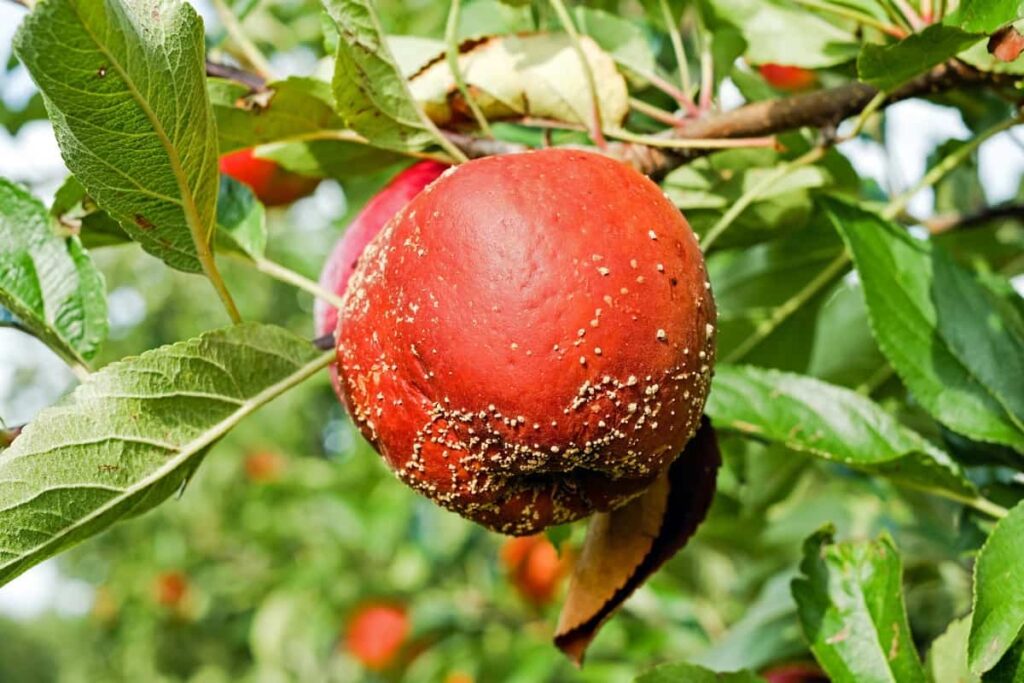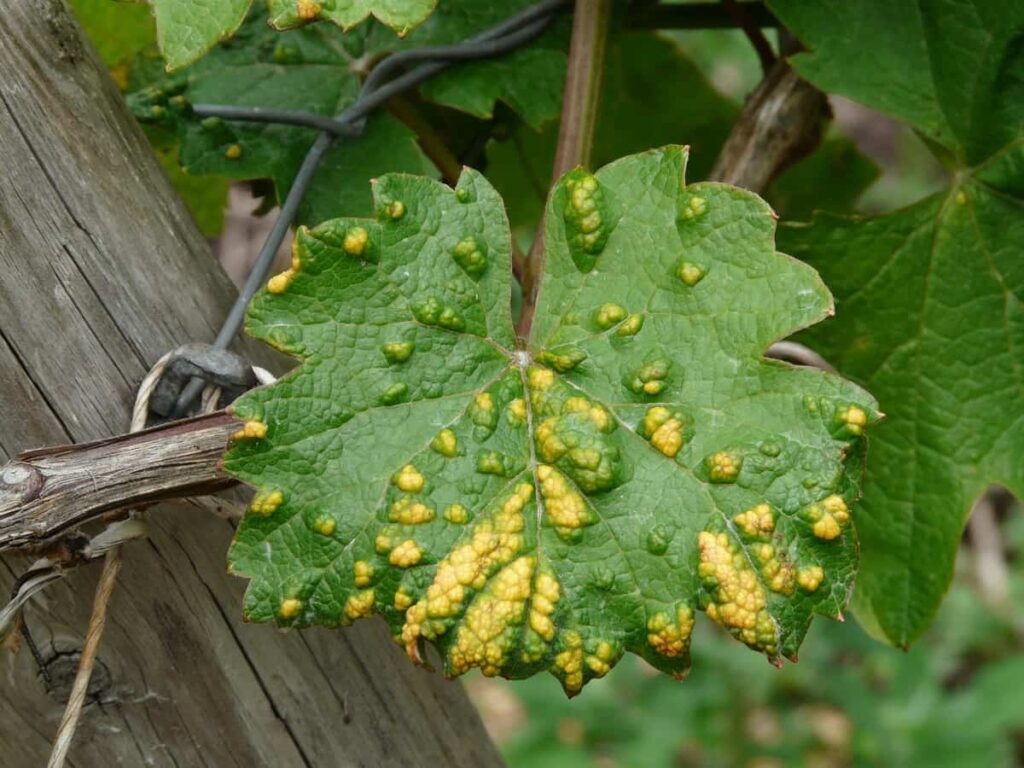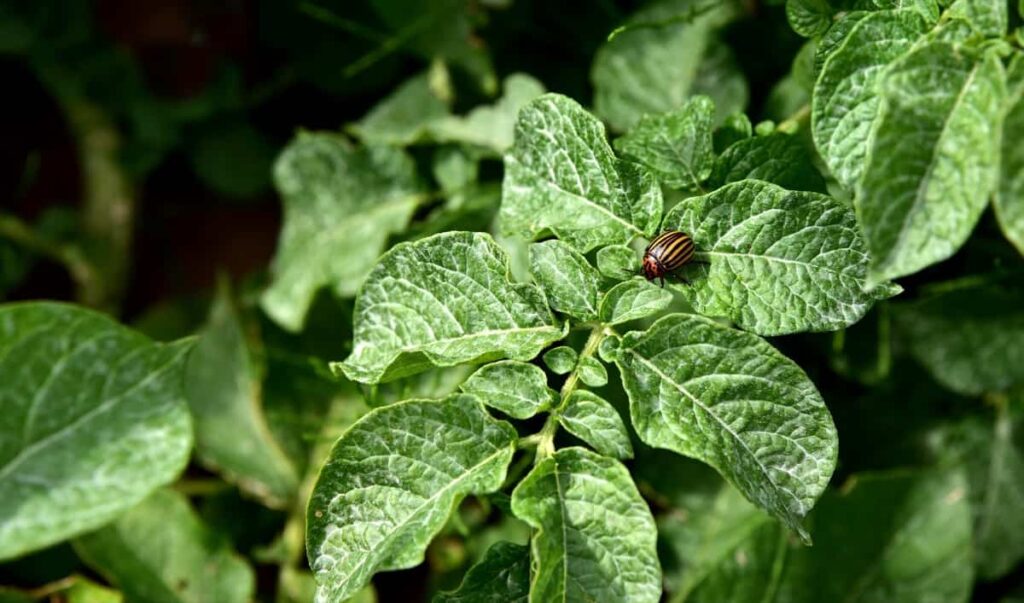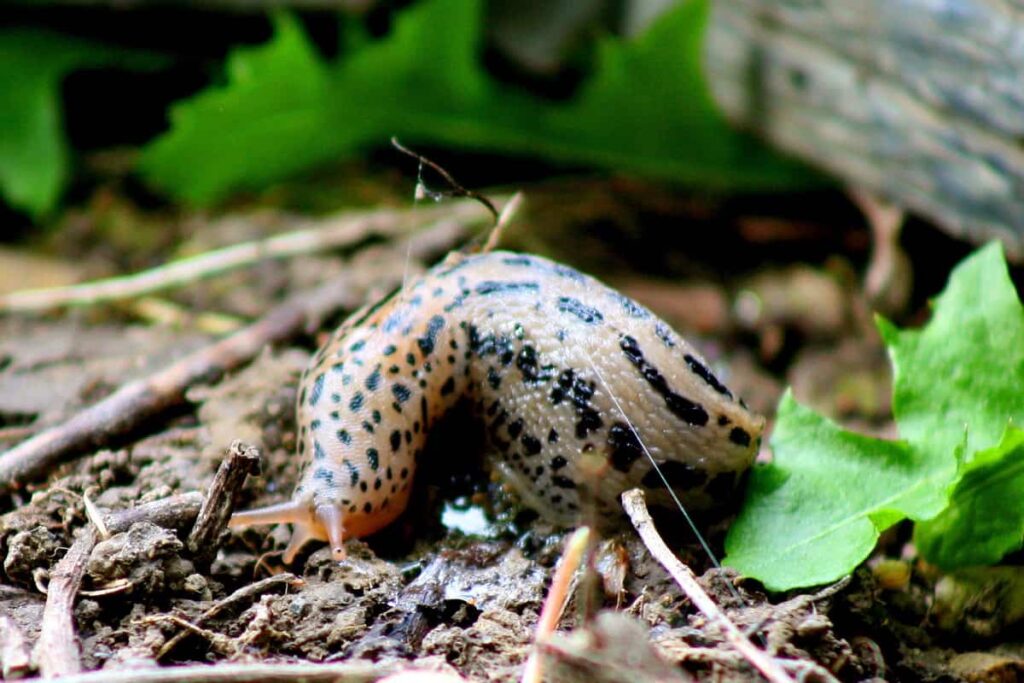Healthy plants can tolerate some pests, but if too many insects decide to live on your plants, they are easily controlled with simple, safe methods. First, it’s important to know what kind of pest exactly you are dealing with. If pests attack your plants, avoid chemicals as much as possible. The issue with insecticides is that they are not only harmful but will also kill beneficial insects that keep pests at bay. Pests can hide in debris in your garden, so keep it clean and free of debris. The following are the most common plant pests and how to control them.

Plant pests and diseases identification
Common plant pests
Aphids
The lifespan of an aphid is about a week, but a mature female can reproduce rapidly. The tiny, pear-shaped creatures have long antennae and two tubes projecting from their abdomens. Most fruits and vegetables, ornamentals, flowers, and shade trees are common places to find them. On the underside of leaves, tiny sucking pests emit a sticky substance that attracts ants and sooty mold.
Control methods
- A strong spray of water should be used to wash plants
- Promote native predators and parasites such as lady beetles, lacewings, and aphid midges
- Plants should be covered with floating row covers whenever possible
- Garlic or hot pepper repellent sprays can be applied
- Neem oil, insecticidal soap, or horticultural oil can be used for severe problems
Thrips
Thrips have fringed wings and are tiny flying insects. Most types of plants are affected by sap-sucking insects, which discolor and distort them. Their excrement leaves tiny black specks on leaves and often creates white patches on petals and leaves. The control of thrips is difficult and usually requires a combination of techniques.
Control methods
- The best method to control them is using sticky traps, neem oil, or insecticidal soap.
- Introduce beneficial insects to attack and destroy this pest, such as minute pirate bugs, thrips predators (feed on eggs and larvae), ladybugs, and lacewings.
- It is possible to treat heavily infested areas with spinosad and neem oil.
Spider mites
Spider mites are somewhat challenging to see with the naked eye, but their fine webs make them easy to identify. Plant-eating spider mites infest more than 180 kinds of plants and look like tiny spiders. They spend the winter resting in the soil in cool climates; they live and feed all year long in warmer climates. In dry, hot conditions, spider mites feed on plant fluid extracted from individual cells with their needle-like mouthparts. If not controlled, the pests will cause the leaves to become streaked, spotted, and discolored.
Control methods
- Lacewing larvae, adult lady beetles, and other predatory insects can help control smaller mite populations.
- Neem oil and insecticidal soap are effective.
- Water adequately, as mites are drawn to dry, dusty conditions.
In case you missed it: When to Apply Organic Pesticides in Your Garden: Best Time, Safety Tips, and Precautions for Beginners

Leaf miners
Leaf miners are larvae of various pests, including moths, flies, and beetles. Larvae attack leaf tissue directly, causing desiccation, premature leaf fall, and cosmetic damage. It can cause the burning of fruit, such as tomatoes and melons, in subtropical areas. As a result of leaf loss, yields are also reduced.
Control methods
- Sticky traps will catch egg-laying adults
- Insecticidal soap will help if control is needed.
- Another way of naturally killing leaf miners is to use neem oil.
Scale
Despite their small size, scale pests can cause devastating damage to flowers by sucking out their nectar. There are two scale types: hard scale found on woody tissues such as branches and twigs, and soft scale, which has a waxy protective covering. A female insect looks like a hard or soft bump on a stem, leaf, or fruit; a male insect is a minute-flying insect, and a larva is a tiny, delicate, crawling insect.
In addition to fruits, indoor plants, shrubs, and trees, they can be found on various ornamental plants. During all stages, the sap is sucked from plants, which weakens them. It results in the yellowing of the leaves, a drop of leaves, and the death of the plants. Also, honeydew is excreted on foliage and fruit.
Control methods
- Control can be difficult, but neem oil suffocates pests well.
- Insecticidal soap is also effective with regular use.
- Prune out infested plant parts and encourage native predators
- Scrub scales gently from twigs with a soft brush and soapy water, and rinse well
- Spray with neem oil
Whiteflies
Another type of sap-sucking pest is the whitefly. It’s important to know that whiteflies aren’t flies, despite their wings and ability to fly. Small whiteflies can be as small as 1/12 of an inch, are somewhat triangular, and are found in clusters on leaves’ undersides. The insect pests can be easier to spot because they are active during the day and scatter when disturbed. While small infestations are relatively harmless, large infestations may cause yellow or dried leaves to drop. Like other sap-sucking pests, whiteflies attract ants and sooty mold with their sweet substance.
In case you missed it: How to Grow Cardamom (Elaichi) from Seeds at Home: Soil, Germination, Planting, Pests, Diseases, and Care

Control methods
- With watering hoses or spray bottles, you can blast whiteflies (as well as aphids and many other insect pests) to scatter them and dislodge their nymphs and eggs.
- Use sticky traps and insecticidal soap or neem oil to control whiteflies.
- Whitefly populations can be controlled by ladybugs, spiders, green lacewing larvae, and dragonflies.
- Another natural predator is the hummingbird.
Earwigs
Although most earwigs are beneficial, they can cause damage to vegetables, dahlias, and mums when they feed on them. They attack many plants, including trees and canes, vegetables, ornamentals, and fruits. They eat buds, leaves, flowers, and fruits. The plant damage is typically caused by small, ragged holes chewed in tissue.
Control methods
- With a short length of garden hose or cooking oil in tuna cans, earwigs are easy to catch.
- Also, you can bait a cardboard box with oatmeal by cutting a tiny hole in the side.
- It would be best to keep the area free of debris since earwigs hide in cool, moist areas.
Cutworms
Cutworms are typically the larva of certain moths. The destructive pests hide under leaves and other plant debris, emerging to lay masses of eggs. They often cut through the stems of young plants at ground level, eating nearly everything in their path. Seedlings are cut near the soil surface by these caterpillars. Sometimes, the cut plants are seen dragged into the holes where the leaves are eaten. Young larvae can create shot holes during their feeding on the tender leaves of seedlings. Plants planted in the early season are very vulnerable to damage from older larvae.
In case you missed it: Custard Apple Diseases and Pests (Sugar Apple): Anthracnose, Black Canker, Diplodia Rot, Leaf Spot, Symptoms, Causes, and Prevention

Control methods
- Remove plant debris and pick off the pests by hand in the late afternoon or evening.
- Create barriers with cardboard collars or gritty substances like eggshells, coffee grounds, or diatomaceous earth.
- Encourage predatory birds to visit the fields by placing birdbaths and feeders near the planting beds
Fungus gnats
Fungus gnats are tiny, annoying pests that will damage houseplants, gardens, or greenhouses. Insect swarms can be annoying, but the larvae that eat plant roots cause the most damage. There is also the possibility that fungus gnats can transmit the disease from plant to plant. High population levels associated with moist, organically-rich soil have caused significant root damage and even death in interior plantscapes and houseplants. Therefore, wilting houseplants may not indicate a lack of water but rather root damage caused by fungus gnat larvae or (more commonly) by other factors.
Control methods
- Control adults with bright yellow sticky traps and insecticidal soap.
- Bti applied at labeled rates provides temporary control and is toxic only to fly larvae, such as mosquitoes, black flies, and fungus gnats.
Mealybugs
The mealybug’s white cottony coating makes it easy to identify when it appears on plant stems and leaves. In northern climates, they mostly affect houseplants and can be found in greenhouses, but rarely outside. However, in warmer climates, they can pose a severe threat to entire crops. By sucking the sap from their host plants, especially new growth, they cause stunted growth, withering, and yellowing.
Control methods
- Insecticidal soap works well against pests. However, light infestations on indoor plants can also be removed with a toothpick, or a cotton swab dipped in rubbing alcohol.
- Soak a cotton ball with regular rubbing alcohol and wipe it on the mealybugs, killing them instantly and removing them.
- Lacebugs, parasitoid wasps, and a beetle, sometimes known as the “mealybug destroyer, ” naturally kill mealybugs. These natural predators are more commonly used for outdoor infestations or in greenhouse situations
Plants diseases
When a plant’s standard structure, growth, function, or other activities are disrupted continuously by some causal agent, the plant becomes diseased. Likewise, interference with one or more essential physiological or biochemical systems of a plant produces characteristic pathological symptoms. The following are the most common plant diseases.
In case you missed it: Types of Insect Pests in Your Garden: Control Methods, Solutions, and Treatment

Powdery Mildew
Powdery mildew is a fungal disease that affects many plants. Powdery mildew can affect many plants, as there are many different species. When fungus takes over a plant, mildew forms on the top, and the spores are carried to other plants by the wind. As a result, dusty white coatings cover leaves, stems, and flowers when powdery mildew is present. If powdery mildew is severe, it can slow down your plants’ growth and reduce the yield and quality of your fruit.
Control methods
- Infected leaves should be raked up and destroyed to prevent spores from spreading.
- Ensure that plants have good drainage and plenty of air circulation.
- Avoid overhead watering at night; mid-morning allows foliage to dry before nightfall.
- Many gardeners have proved baking soda to be effective in treating powdery mildew. One teaspoon of baking soda should be in 1 quart of water. Spray plants thoroughly, as the solution will only kill the fungus when it comes into contact.
Downy Mildew
Impatiens, pansies, grapevines, columbine, lettuce, and cole crops such as broccoli and cauliflower are all susceptible to downy mildew, which is caused by fungus-like organisms. In wet weather, downy mildew often discolors the upper portion of leaves, while white or gray mold forms on the bottom.
Control methods
- You should destroy infected foliage or entire plants if downy mildew is prevalent.
- Plants should not be crowded or watered at night, and edibles should be rotated annually.
- A copper fungicide is often used to control downy mildew.
Black Spot
It is a fungal disease commonly found in roses but can also affect other flowers and fruits. Despite not killing plants outright, it weakens them and makes them more susceptible to other problems. When the weather is cool and moist, small black spots appear on the foliage, which turns yellow and eventually dies.
Control methods
- Avoid overhead watering and water the plants early in the day so the foliage can dry before nightfall.
- Improve the air circulation around your plant by spacing them appropriately and pruning them regularly.
- Several environmentally friendly organic products do an excellent job suppressing black spots, including sulfur, neem oil, and copper.
Mosaic Virus
The most common mosaic viruses encountered by gardeners are tomato and tobacco mosaics. In the former, tomatoes, peppers, potatoes, apples, pears, and cherries are infected; in the latter, tomatoes, peppers, cucumbers, lettuce, beets, petunias, and tobacco are infected. Viruses that cause mosaics can result in mottled yellow and green leaves curled and distorted. Due to this, some plants exhibit yellowing, stunted growth, and malformed fruits. Viruses that cause mosaics are more prevalent during hot weather.
Control methods
- Remove all infected plants, burn them, or throw them out with the garbage.
- Avoid planting susceptible plants in the same spot for two years.
- Gardening tools should be disinfected after every use. Wipe down your tools with a weak bleach solution or antiviral disinfectant.
- To avoid seed-borne mosaic viruses, soak the seeds of susceptible plants in a 10% bleach solution before planting.
Damping-Off disease
Several soil-borne fungi cause damping-off disease, most prevalent in wet, humid conditions. Typically, damping-off occurs when old seeds are planted in cold, damp soil temperatures and are further exacerbated by poor soil drainage. High humidity levels, cool soil, rich potting soil, and planting too deeply will also encourage its growth. Seedlings are infected with it and collapse and decay as a result. The disease is commonly found in greenhouses, but it can also occur outdoors.
Control methods
- Use new pots, cell packs, and trays, or disinfect with a 10 percent bleach solution.
- Fill with fresh, bagged, soilless potting mix, avoid crowding seedlings and provide adequate ventilation.
- Use a potting mix with good drainage. Water to keep it moist but not soggy. Use pots with drainage holes to ensure good drainage of excess water.
In case you missed it: Top 10 Pollution killer Plants: Indoors and Outdoors
Fusarium Wilt
Fusarium wilt is a soil-borne fungus that affects ornamental and edible plants, such as dianthus, beans, tomatoes, peas, and asparagus. Plants with the disease have wilted leaves, stunted growth, root rot, and blackened stems. Hot summer temperatures are the most conducive to its activity. Lower (older) leaves are often the first to show disease symptoms later in the growing season. With the disease’s progression and the plant’s death, the younger leaves will also be affected. Many plants only display symptoms on one branch or side.
Control methods
- High nitrogen fertilizers may increase susceptibility to the disease. Instead, test your soil and use a slow-release, organic fertilizer in the vegetable garden.
- Hand pull or spot treat weeds using a weed flamer or natural herbicide — many weed species hosts the disease pathogen.
- Apply soil-based fungicides on contaminated locations if no other measures are effective. The soil should be drenched with copper oxychloride (3g/l) of water before sowing/transplanting is also effective.
Verticillium Wilt
Hundreds of species of trees, edibles, shrubs, and ornamentals are affected by verticillium wilt. Through the roots, pathogens live in the soil for years and eventually clog the vascular system, causing branches to wilt suddenly and foliage to turn yellow and fall off prematurely. Growth can also be stunted as a result.
Control methods
- Water the plant regularly, and when possible, provide afternoon shade.
- Fertilize on schedule using a low-nitrogen, high-phosphorus fertilizer.
- Prune off dead and dying branches.
- Verticillium wilt can’t be cured once it enters the plant. Therefore, removing and destroying small, easily replaced plants is best.
Rust
Like freckles, rust spots are usually tiny and scattered across plant foliage. However, there can be dozens of rust spots on each leaf, and a single leaf can have more than a hundred rust spots. As a result, the leaves of plants with a heavy rust infestation might curl or wither, and the plant can lose its leaves entirely. You can expect stunted growth in your plants if this much damage occurs.
Control methods
- The most crucial step to reduce rust in your flower garden is to stop overhead watering. Alternatively, use a drip irrigation system or a watering wand to deliver water at ground level.
- A weekly dusting of sulfur can prevent and treat rust fungus.
- Neem oil, a botanical fungicide and pesticide, also control rust.
- Some organic gardeners swear by baking soda to control garden fungus. However, the efficacy of baking soda spray might be enhanced by mixing it with light horticultural oil.
Conclusion
These pests and diseases significantly affect the yield and yield quality. By applying modern cultivating techniques and cultivating disease-resistant varieties, disease occurrence can be prevented up to some extent. If your plants are affected by any pest or disease, they should be controlled at the initial stage to avoid loss.
- How to Grow Tomatoes Organically at Home: A Comprehensive Guide
- Organic Gardening on a Budget: Low-Cost Methods and Materials
- Gongura Seed Germination and Planting Methods
- Cabbage Seed Germination and Selection
- Broccoli Seed Germination and Selection
- Asparagus Seed Germination and Variety Selection
- Seasonal Flower Gardening: Best Practices for Spring, Summer, Fall, and Winter
- How to Grow Hibiscus from Flower
- Plantation Ideas for Home Decoration: A Beginners Guide
- Flower Garden Designs and Layouts for Beginners
- Planting and Spacing Techniques in Papaya: A Beginner’s Guide
- Growing Gold: Essential Techniques for Planting Pineapples
- How to Make Kalanchoe Plant Bushy: Home Remedies and Solutions
- 11 Reasons Why Your Gardenia is Not Blooming: Home Remedies and Solutions
- Eco Elegance: The Guide to Designing a Drought-Tolerant Landscape
- Gardening on a Slope: Strategies for Hillside Landscaping
- Nourish and Flourish: Top Organic Mulches for Thriving House Plants
- Everything You Want to Know about Indian Mogra Flower: Discover Uses and Growing
- Green Thumb Success: Expert Tips for Cultivating Greenhouse Pumpkins All Year Round
- Maximize Growth & Flavor: The Ultimate Guide to Companion Planting in Herb Gardens
- How to Control Rhododendron Problems Naturally: Home Remedies and Organic Ways to Fix Them
- Natural Magic: The Remarkable Benefits of Cinnamon for Plants
- Best Steps to Revive Dying Tulip with Natural and Organic Treatment
- 10 Reasons Why Your Angel Trumpet is Not Blooming: Remedies and Treatment
- How to Fix Periwinkle Leaf and Flower-Related Problems: Natural Remedies and Solutions
- How to Fix Zinnias Leaf and Flower Problems: Discover Natural and Home Remedies
- Organic Steps to Induce Lemon Tree Flowers: A Comprehensive Guide
- Bloom Booster: Crafting the Perfect Homemade Bougainvillea Fertilizer
- Optimizing Growth: A Guide to Applying NPK Fertilizer for Potted Plants
- 10 Best Homemade Fertilizers for Rubber Plant: DIY Recipes and Application Method
- How to Boost Female Pumpkin Flowers: Effective Steps for More Flowers and High Yields
- Transform Your Indoor Garden: Top Benefits of Pink Salt for Houseplants
- 10 Best Homemade Fertilizers for Peacock Plants (Calathea): Easy DIY Guide
- Unlock Blooms: 9 Reasons Why Your Potted Chrysanthemum is Not Blooming
- 8 Reasons Why Your Potted Hibiscus is Not Blooming: Fix it with Simple Solutions
- Unlock Blooms: 9 Key Reasons Your Potted Frangipani Won’t Flower
